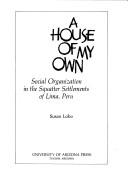| Listing 1 - 10 of 48 | << page >> |
Sort by
|
Book
ISBN: 1787355225 1787355217 Year: 2020 Publisher: London : UCL Press,
Abstract | Keywords | Export | Availability | Bookmark
 Loading...
Loading...Choose an application
- Reference Manager
- EndNote
- RefWorks (Direct export to RefWorks)
Comparative Approaches to Informal Housing Around the Globe brings together historians, anthropologists, political scientists, sociologists, urban planners and political activists to break new ground in the globalisation of knowledge about informal housing. Providing both methodological reflections and practical examples, they compare informal settlements, unauthorised occupation of flats, illegal housing construction and political squatting in different regions of the world. Subjects covered include squatter settlements in Kyrgyzstan and Kazakhstan, squatting activism in Brazil and Spain, right-wing squatting in Germany, planning laws and informality across countries in the Global North, and squatting in post-Second World War UK and Australia.
Squatter settlements. --- Informal settlements (Squatter settlements) --- Irregular settlements --- Settlements, Spontaneous --- Settlements, Squatter --- Shack towns --- Shanty towns --- Shantytowns --- Spontaneous settlements --- Uncontrolled settlements --- Cities and towns --- Slums
Book
ISBN: 9780674968967 0674968964 9780674660458 0674660455 0674968980 Year: 2016 Publisher: Cambridge, MA
Abstract | Keywords | Export | Availability | Bookmark
 Loading...
Loading...Choose an application
- Reference Manager
- EndNote
- RefWorks (Direct export to RefWorks)
Shantytowns once occupied a central place in America’s urban landscape. Lisa Goff shows how these resourceful dwellings were not merely the byproducts of hardship but potent assertions of self-reliance. Their legacy is felt in sites of political activism, from campus shanties protesting apartheid to the tent cities of Occupy Wall Street.
Squatter settlements --- Slums --- Slum clearance --- Housing --- Informal settlements (Squatter settlements) --- Irregular settlements --- Settlements, Spontaneous --- Settlements, Squatter --- Shack towns --- Shanty towns --- Shantytowns --- Spontaneous settlements --- Uncontrolled settlements --- Cities and towns --- History
Book
ISBN: 9811373078 981137306X Year: 2021 Publisher: Springer Singapore
Abstract | Keywords | Export | Availability | Bookmark
 Loading...
Loading...Choose an application
- Reference Manager
- EndNote
- RefWorks (Direct export to RefWorks)
This book focuses on the implementation of slum upgrading projects and the last generation of citywide programmes that define the future urban configuration of informal settlements, from a citywide perspective, in the Earth’s tropical region. The book presents a study on regeneration experiences in Asia and Latin America and it identifies important points of connection and similarities between the two cases, while also determining that, compared to Asia, informality in Latin America is in its ‘second generation.’.
Squatter settlements --- Sustainability. --- Informal settlements (Squatter settlements) --- Irregular settlements --- Settlements, Spontaneous --- Settlements, Squatter --- Shack towns --- Shanty towns --- Shantytowns --- Spontaneous settlements --- Uncontrolled settlements --- Cities and towns --- Slums --- Sustainability science --- Human ecology --- Social ecology
Book
ISBN: 3030708497 3030708489 Year: 2021 Publisher: Cham, Switzerland : Palgrave Macmillan,
Abstract | Keywords | Export | Availability | Bookmark
 Loading...
Loading...Choose an application
- Reference Manager
- EndNote
- RefWorks (Direct export to RefWorks)
Sociology, Urban --- Squatter settlements --- Informal settlements (Squatter settlements) --- Irregular settlements --- Settlements, Spontaneous --- Settlements, Squatter --- Shack towns --- Shanty towns --- Shantytowns --- Spontaneous settlements --- Uncontrolled settlements --- Cities and towns --- Slums --- Urban sociology
Book
ISBN: 9780415812528 0415812526 Year: 2013 Publisher: London Routledge
Abstract | Keywords | Export | Availability | Bookmark
 Loading...
Loading...Choose an application
- Reference Manager
- EndNote
- RefWorks (Direct export to RefWorks)
Pour l’anthropologue qui s’intéresse depuis vingt ans à Dharavi, slum super star qui rassemble environ 800 000 personnes sur 3 km2 à l’épicentre de Mumbai, il s’agit de questionner l’organisation de ces « slums » définis officiellement par leur insalubrité et par leur « illégalité » afin de montrer qu’ils sont partie prenante des dynamiques urbaines contemporaines et qu’ils redéfinissent les modes traditionnels de régulations urbaines. Dharavi, fourmilière industrieuse accueillant d´abord les migrants de basses castes écrasés sous le poids des hiérarchies traditionnelles et des inégalités va s’imposer par ses connexions à la ville formelle. En même temps, l’incroyable boom immobilier de Mumbai va situer Dharavi au centre des convoitises pour en faire un laboratoire de projets de logement et de réhabilitation uniques par leur montage et leur dimension politique. Dans ces slums, l’apparente destructuration du lien social est ainsi le lieu de reformulation de nouveaux modes d’être-ensemble qui renversent les clichés sur le bidonville anomique et pouilleux. C’est aussi au-delà de l’apparent chaos que s’organise une réflexion sur comment habiter la ville, concevoir le lien urbain, penser un citoyen et son « droit à la ville ». Cela en partant du terrain, de ces bicoques où l’on vit et travaille à la fois, de ces réseaux migratoires de castes qui relient la mégapole au village.
economic development --- Social stratification --- shantytowns --- Economic geography --- Mumbai --- Bidonville --- Informal sector (Economics) --- Inde --- Dhārāvi (Mumbai, India) --- Social conditions --- Economic conditions --- Informal sector (Economics) - India - Mumbai --- Dhārāvi (Mumbai, India) - Social conditions --- Dhārāvi (Mumbai, India) - Economic conditions
Book
ISBN: 0566002663 Year: 1979 Publisher: Farnborough Saxon house
Abstract | Keywords | Export | Availability | Bookmark
 Loading...
Loading...Choose an application
- Reference Manager
- EndNote
- RefWorks (Direct export to RefWorks)
Squatter settlements --- Housing rehabilitation --- Case studies. --- Informal settlements (Squatter settlements) --- Irregular settlements --- Settlements, Spontaneous --- Settlements, Squatter --- Shack towns --- Shanty towns --- Shantytowns --- Spontaneous settlements --- Uncontrolled settlements --- Cities and towns --- Slums --- Buildings --- Housing policy --- Urban renewal --- Case studies --- Repair and reconstruction --- Lusaka (Zambia). --- Lusaska, Zambia.

ISBN: 848930209X 9788489302099 Year: 1991 Volume: 60 Publisher: Lima IFEA
Abstract | Keywords | Export | Availability | Bookmark
 Loading...
Loading...Choose an application
- Reference Manager
- EndNote
- RefWorks (Direct export to RefWorks)
Squatter settlements --- Slums --- Housing policy --- History. --- -Slums --- -Housing policy --- -Housing --- Housing and state --- State and housing --- City planning --- Social policy --- Slum clearance --- Housing --- Informal settlements (Squatter settlements) --- Irregular settlements --- Settlements, Spontaneous --- Settlements, Squatter --- Shack towns --- Shanty towns --- Shantytowns --- Spontaneous settlements --- Uncontrolled settlements --- Cities and towns --- History --- Government policy --- -History --- Squatter settlements - Peru - Lima - History. --- Slums - Peru - Lima - History. --- Housing policy - Peru - Lima.

ISBN: 0816507619 0816507392 Year: 1983 Publisher: Tucson University of Arizona press
Abstract | Keywords | Export | Availability | Bookmark
 Loading...
Loading...Choose an application
- Reference Manager
- EndNote
- RefWorks (Direct export to RefWorks)
"A fairly comprehensive monograph, highly suitable for classroom use, that offers a wide range of information fit into traditional anthropological categories. . . . an interesting study of cultural integrity and pattern in a setting of what appears to be complex sociopolitical chaos." -American Anthropologist "Whether or not one accepts Susan Lobo's optimistic analysis, her ability to translate the apparent chaos of shanty-town lives into such neat patterns and to help outsiders view life as the inhabitants do are important contributions." -Inter-American Review of Bibliography "An extremely competent ethnography, simple and straightforward." -Anthropos "A pleasure to read, a mine of information which will be useful in teaching students to formulate their own hypotheses." -International Journal of Urban & Regional Research "Very well written and provides a great wealth of the liveliest sort of ethnographic detail." -Latin American Research Review "Lobo's study of two squatter settlements in Lima provides a solid, well-written, detailed, traditional ethnography of poor families in a Third World urban setting." -Hispanic American Historical Review "This well-written account . . . has a lot of heart and feeling for the human face of the urban poor." -International Migration Review
Squatter settlements --- Community development --- Informal settlements (Squatter settlements) --- Irregular settlements --- Settlements, Spontaneous --- Settlements, Squatter --- Shack towns --- Shanty towns --- Shantytowns --- Spontaneous settlements --- Uncontrolled settlements --- Cities and towns --- Slums --- Regional development --- Economic assistance, Domestic --- Social planning --- Citizen participation --- Government policy --- Lima (Peru) --- Ciudad de los Reyes (Peru) --- Chorrillos (Peru) --- Social conditions.
Book
ISBN: 1464803021 1464803013 Year: 2014 Publisher: Washington, DC : The World Bank Group,
Abstract | Keywords | Export | Availability | Bookmark
 Loading...
Loading...Choose an application
- Reference Manager
- EndNote
- RefWorks (Direct export to RefWorks)
Countries everywhere are divided within into two distinct spatial realms: one urban, one rural. Classic models of development predict faster growth in the urban sector, causing rapid migration from rural areas to cities, lifting average incomes in both places. The situation in South Africa throws up an unconventional challenge. The country has symptoms of a spatial realm that is not not rural, not fully urban, lying somewhat in limbo. This is the realm of the country's townships and informal settlements (T&IS). In many ways, the townships and especially the informal settlements are similar to
Blacks --- Economic development --- Slums --- Squatter settlements --- Economic conditions. --- South Africa --- Economic policy. --- Slum clearance --- Informal settlements (Squatter settlements) --- Irregular settlements --- Settlements, Spontaneous --- Settlements, Squatter --- Shack towns --- Shanty towns --- Shantytowns --- Spontaneous settlements --- Uncontrolled settlements --- Cities and towns --- Housing --- Black persons --- Negroes --- Ethnology --- Black people
Multi
ISBN: 9052691258 Year: 1993 Publisher: Delft : Fakulteit der Bouwkunde, TU-Delft,
Abstract | Keywords | Export | Availability | Bookmark
 Loading...
Loading...Choose an application
- Reference Manager
- EndNote
- RefWorks (Direct export to RefWorks)
Suburbs --- Squatter settlements --- Cities and towns, Medieval --- Urbanization --- City planning --- Medieval cities and towns --- Informal settlements (Squatter settlements) --- Irregular settlements --- Settlements, Spontaneous --- Settlements, Squatter --- Shack towns --- Shanty towns --- Shantytowns --- Spontaneous settlements --- Uncontrolled settlements --- Cities and towns --- Slums --- Outskirts of cities --- Suburban areas --- Suburbia --- Metropolitan areas --- History. --- Growth --- Theses --- History --- Growth&delete& --- Géographie urbaine
| Listing 1 - 10 of 48 | << page >> |
Sort by
|

 Search
Search Feedback
Feedback About UniCat
About UniCat  Help
Help News
News